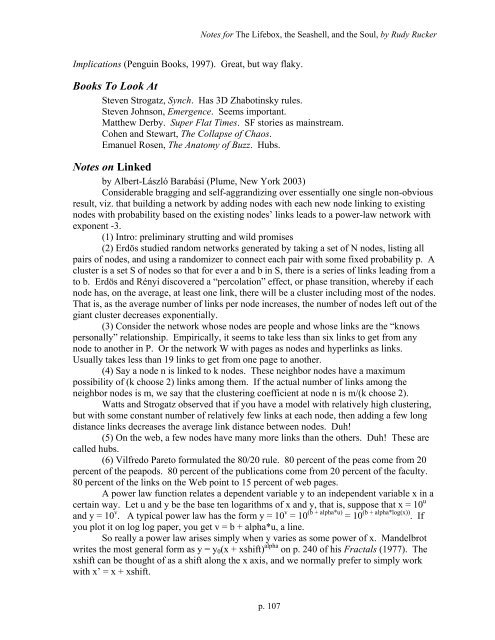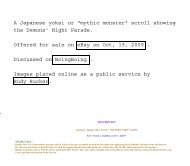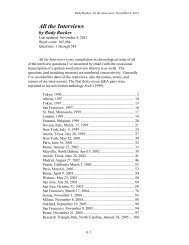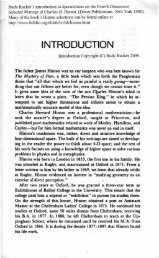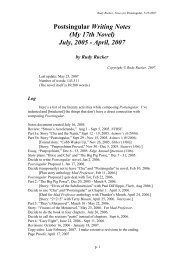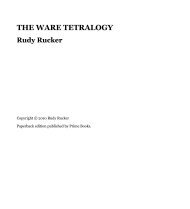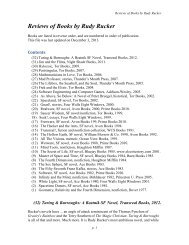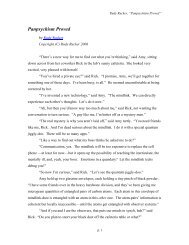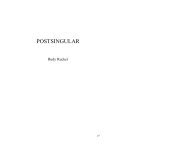Notes for the Lifebox, the Seashell, and the Soul - Rudy Rucker
Notes for the Lifebox, the Seashell, and the Soul - Rudy Rucker
Notes for the Lifebox, the Seashell, and the Soul - Rudy Rucker
Create successful ePaper yourself
Turn your PDF publications into a flip-book with our unique Google optimized e-Paper software.
<strong>Notes</strong> <strong>for</strong> The <strong>Lifebox</strong>, <strong>the</strong> <strong>Seashell</strong>, <strong>and</strong> <strong>the</strong> <strong>Soul</strong>, by <strong>Rudy</strong> <strong>Rucker</strong><br />
Implications (Penguin Books, 1997). Great, but way flaky.<br />
Books To Look At<br />
Steven Strogatz, Synch. Has 3D Zhabotinsky rules.<br />
Steven Johnson, Emergence. Seems important.<br />
Mat<strong>the</strong>w Derby. Super Flat Times. SF stories as mainstream.<br />
Cohen <strong>and</strong> Stewart, The Collapse of Chaos.<br />
Emanuel Rosen, The Anatomy of Buzz. Hubs.<br />
<strong>Notes</strong> on Linked<br />
by Albert-László Barabási (Plume, New York 2003)<br />
Considerable bragging <strong>and</strong> self-aggr<strong>and</strong>izing over essentially one single non-obvious<br />
result, viz. that building a network by adding nodes with each new node linking to existing<br />
nodes with probability based on <strong>the</strong> existing nodes’ links leads to a power-law network with<br />
exponent -3.<br />
(1) Intro: preliminary strutting <strong>and</strong> wild promises<br />
(2) Erdös studied r<strong>and</strong>om networks generated by taking a set of N nodes, listing all<br />
pairs of nodes, <strong>and</strong> using a r<strong>and</strong>omizer to connect each pair with some fixed probability p. A<br />
cluster is a set S of nodes so that <strong>for</strong> ever a <strong>and</strong> b in S, <strong>the</strong>re is a series of links leading from a<br />
to b. Erdös <strong>and</strong> Rényi discovered a “percolation” effect, or phase transition, whereby if each<br />
node has, on <strong>the</strong> average, at least one link, <strong>the</strong>re will be a cluster including most of <strong>the</strong> nodes.<br />
That is, as <strong>the</strong> average number of links per node increases, <strong>the</strong> number of nodes left out of <strong>the</strong><br />
giant cluster decreases exponentially.<br />
(3) Consider <strong>the</strong> network whose nodes are people <strong>and</strong> whose links are <strong>the</strong> “knows<br />
personally” relationship. Empirically, it seems to take less than six links to get from any<br />
node to ano<strong>the</strong>r in P. Or <strong>the</strong> network W with pages as nodes <strong>and</strong> hyperlinks as links.<br />
Usually takes less than 19 links to get from one page to ano<strong>the</strong>r.<br />
(4) Say a node n is linked to k nodes. These neighbor nodes have a maximum<br />
possibility of (k choose 2) links among <strong>the</strong>m. If <strong>the</strong> actual number of links among <strong>the</strong><br />
neighbor nodes is m, we say that <strong>the</strong> clustering coefficient at node n is m/(k choose 2).<br />
Watts <strong>and</strong> Strogatz observed that if you have a model with relatively high clustering,<br />
but with some constant number of relatively few links at each node, <strong>the</strong>n adding a few long<br />
distance links decreases <strong>the</strong> average link distance between nodes. Duh!<br />
(5) On <strong>the</strong> web, a few nodes have many more links than <strong>the</strong> o<strong>the</strong>rs. Duh! These are<br />
called hubs.<br />
(6) Vilfredo Pareto <strong>for</strong>mulated <strong>the</strong> 80/20 rule. 80 percent of <strong>the</strong> peas come from 20<br />
percent of <strong>the</strong> peapods. 80 percent of <strong>the</strong> publications come from 20 percent of <strong>the</strong> faculty.<br />
80 percent of <strong>the</strong> links on <strong>the</strong> Web point to 15 percent of web pages.<br />
A power law function relates a dependent variable y to an independent variable x in a<br />
certain way. Let u <strong>and</strong> y be <strong>the</strong> base ten logarithms of x <strong>and</strong> y, that is, suppose that x = 10 u<br />
<strong>and</strong> y = 10 v . A typical power law has <strong>the</strong> <strong>for</strong>m y = 10 v = 10 (b + alpha*u) = 10 (b + alpha*log(x)) . If<br />
you plot it on log log paper, you get v = b + alpha*u, a line.<br />
So really a power law arises simply when y varies as some power of x. M<strong>and</strong>elbrot<br />
writes <strong>the</strong> most general <strong>for</strong>m as y = y 0 (x + xshift) alpha on p. 240 of his Fractals (1977). The<br />
xshift can be thought of as a shift along <strong>the</strong> x axis, <strong>and</strong> we normally prefer to simply work<br />
with x’ = x + xshift.<br />
p. 107


